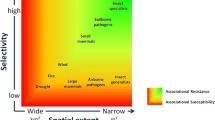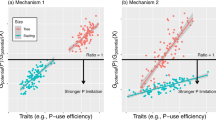Abstract
Adaptive trade-offs underlie the specialisation that permits habitat partitioning in species rich plant communities. We investigated the influence of the trade-offs that determine differences in growth and survival among six species of neotropical pioneer trees in gaps in semideciduous forest in Panama. Seedlings of Miconia argentea, Cecropia insignis, Luehea seemannii, Trema micrantha, Ochroma pyramidale and Croton bilbergianus were planted into artificial small (25 m2), medium (64 m2) and large (225 m2) gaps in secondary forest in the Barro Colorado Nature Monument. Trema and Ochroma suffered ≥50% mortality across all gap sizes, while Cecropia had high mortality only during the dry season and in the small gaps, and Miconia and Croton suffered low to zero mortality across all environments. The highest growth rates in large gaps were attained by Cecropia seedlings and in the smaller gaps by Miconia seedlings, although there were indications that Trema and Ochroma required gaps that were larger than any used in this study. Variation in growth and mortality could not be attributed to differences in foliar herbivore damage. Instead, there was strong evidence of a trade-off between maximum growth in the wet season and the ability to survive seasonal drought, particularly in small gaps. We conclude that variation in allocation in response to multiple limiting resources may be as important as allocation to growth and defence in determining the habitat preferences of neotropical pioneers.







Similar content being viewed by others
References
Barone JA (1998) Host-specificity of folivorous insects in a moist tropical forest. J Anim Ecol 67:400–409
Bazzaz FA (1979) The physiological ecology of plant succession. Annu Rev Ecol Syst 10:351–371
Bazzaz FA, Pickett STA (1980) Physiological ecology of tropical succession: a comparative review. Annu Rev Ecol Syst 11:287–310
Boardman NK (1977) Comparative photosynthesis of sun and shade plants. Annu Rev Plant Physiol 28:355–377
Brokaw NVL (1987) Gap-phase regeneration of three pioneer tree species in a tropical forest. J Ecol 75:9–19
Burslem DFRP (1996) Differential responses to nutrients, shade and drought among tree seedlings in lowland tropical forest in Singapore. In: Swaine MD (ed) The ecology of tropical forest tree seedlings. UNESCO Man and the biosphere series. Parthenon, Carnforth, UK, pp 211–244
Canham CD, Berkowitz AR, Kelly VR, Lovett GM, Ollinger SV, Schurr J (1996) Biomass allocation and multiple resource limitation in tree seedlings. Can J For Res 26:1521–1530
Chapin FS, Bloom AJ, Field CB, Waring RH (1987) Plant responses to multiple environmental factors. BioScience 37:49–57
Chazdon RL (1988) Sunflecks and their importance to forest understorey plants. Adv Ecol Res 18:1–63
Clements FE (1916) Plant succession. Carnegie Inst Wash Publ 242:1–512
Clements FE, Weaver JE, Hanson HC (1929) Plant Succession. Carnegie Inst Wash Publ 398:1–340
Coley PD (1983) Herbivory and defensive characteristics of tree species in a lowland tropical forest. Ecol Monogr 53:209–233
Coley PD, Bryant JP, Chapin FS III (1985) Resource availability and plant antiherbivore defense. Science 230:895–899
Cornelissen JHC, Castro-Díez P, Carnelli AL (1998) Variation in relative growth rate among woody species. In: Lambers H, Poorter H, Van Vuuren MMI (eds) Inherent variation in plant growth. Physiological mechanisms and ecological consequences. Backhuys, Leiden, pp 363–392
Crawley MJ (1990) The population dynamics of plants. Phil Trans R Soc B 330:125–140
Croat TB (1978) Flora of Barro Colorado Island. Stanford University Press, Stanford, Calif.
Dalling JW, Hubbell SP (2002) Seed size, growth rate and gap microsite conditions as determinants of recruitment success for pioneer species. J Ecol 90:557–568
Dalling JW, Swaine MD, Garwood NC (1997) Soil seed bank community dynamics in seasonally moist lowland tropical forest, Panama. J Trop Ecol 13:659–680
Dalling JW, Lovelock CE, Hubbell SP (1999) Growth responses of seedlings of two neotropical pioneer species to simulated forest gap environments. J Trop Ecol 15:827–839
Darwin C (1859) The origin of species by means of natural selection or the preservation of favoured races in the struggle for life. Murray, London, UK
Evans GC (1972) The quantitative analysis of plant growth. Blackwell, Oxford
Filip V, Dirzo R, Maass JM, Sarukhán J (1995) Within- and among-year variation in the levels of herbivory on the foliage of trees from a Mexican tropical deciduous forest. Biotropica 27:78–86
Givnish TJ (1988) Adaptation to sun and shade: a whole plant perspective. Aust J Plant Physiol 15:63–92
Grime JP (1979) Plant strategies and vegetation processes. Wiley, New York
Grubb PJ (1977) The maintenance of species richness in plant communities: the importance of the regeneration niche. Biol Rev 52:107–145
Grubb PJ (1996) Rainforest dynamics: the need for new paradigms. In: Edwards DS, Choy SC, Booth WE (eds) Tropical rainforest research—current issues. Kluwer, The Hague, pp 215–233
Grubb PJ, Lee WG, Kollmann J, Bastow Wilson J (1996) Interaction of irradiance and soil nutrient-supply on growth of seedlings of ten European tall-shrub species and Fagus sylvatica. J Ecol 84:827–840
Holmgren M (2000) Combined effects of shade and drought on tulip poplar seedlings: trade-off in tolerance and facilitation? Oikos 90:67–78
Hubbell SP (2001) The unified neutral theory of biodiversity and biogeography. Princeton University Press, N.J., USA
Hubbell SP, Foster RB (1992) Short-term dynamics of a neotropical forest: why ecological research matters to tropical conservation and management. Oikos 63:48–61
Huston MA, Smith TM (1987) Plant succession: life history and competition. Am Nat 130:168–198
Kitajima K (1994) Relative importance of photosynthetic traits and allocation patterns as correlates of seedling tolerance of 13 tropical trees. Oecologia 98:419–428
Kitajima K (1996) Cotyledon functional morphology, patterns of seed reserve utilization and regeneration niches of tropical tree seedlings. In: Swaine MD (ed) Ecology of tropical forest tree seedlings. UNESCO-Parthenon, Paris, pp 193–210
Kobe RK (1999) Light gradient partitioning among tropical tree species through differential seedling mortality and growth. Ecology 80:187–201
Kobe RK, Pacala SW, Silander JA, Canham CD (1995) Juvenile tree survivorship as a component of shade tolerance. Ecol Appl 5:517–532
Kolb TE, Steiner KC, McCormick LH, Bowersox TW (1990) Growth response of northern red-oak and yellow-poplar seedlings to light, soil moisture, and nutrients in relation to ecological strategy. For Ecol Manage 38:65–78
Latham RE (1992) Co-occurring tree species change rank in seedling performance with resources varied experimentally. Ecology 73:2129–2144
Loach K (1967) Shade tolerance in tree seedlings. I. Leaf photosynthesis and respiration in plants raised under artificial shade. New Phytol 66:607–621
Peace WJH, Grubb PJ (1982) Interaction of light and mineral nutrient supply in the growth of Impatiens parviflora. New Phytol 90:127–150
Pearson TRH (2002) Mechanisms of coexistence among neotropical pioneer tree species. PhD Thesis, University of Aberdeen
Pearson TRH, Burslem DFRP, Mullins CE, Dalling JW (2002) Germination ecology of neotropical pioneers: interacting effects of environmental conditions and seed size. Ecology 83:2798–2807
Poorter L (1999) Growth responses of 15 rain-forest tree species to a light gradient: the relative importance of morphological and physiological traits. Funct Ecol 13:396–410
Rand AS, Rand WM (1982) Variation in rainfall on Barro Colorado Island. In: Leigh E, Rand A, Windsor D (eds) The ecology of a tropical forest. Smithsonian Institution, Washington, D.C., pp 47–66
Sack L, Grubb PJ (2001) Why do species of woody seedlings change rank in relative growth rate between low and high irradiance? Funct Ecol 15:145–154
Sheil D, Burslem DFRP, Alder D (1995) The interpretation and misinterpretation of mortality rate measures. J Ecol 83:331–333
Smith TM, Huston MA (1989) A theory of the spatial and temporal dynamics of plant communities. Vegetatio 83:49–69
Swaine MD, Whitmore TC (1988) On the definition of ecological species groups in tropical rain forest. Vegetatio 75:81–86
Thomas SC, Bazzaz FA (1999) Asymptotic height as a predictor of photosynthetic characteristics in Malaysian rain forest trees. Ecology 80:1608–1622
Walters MB, Reich PB (1996) Are shade tolerance, survival, and growth linked? Low light and nitrogen effects on hardwood seedlings. Ecology 77:841–853
Wright SJ (1991) Seasonal drought and the phenology of understory shrubs in a tropical moist forest. Ecology 72:1643–1657
Wright SJ (2002) Plant diversity in tropical forests: a review of mechanisms of species coexistence. Oecologia 130:1–14
Wright SJ, Cornejo FH (1990) Seasonal drought and leaf fall in a tropical forest. Ecology 71:1165–1175
Zipperlen SW, Press MC (1997) Photosynthesis in relation to growth and seedling ecology of two dipterocarp rain forest tree species. J Ecol 85:491–503
Acknowledgements
We thank David Galvez, Tobias Koehler, Alyssa Stocks, Javier Ballesteros and Evelyn Sánchez for field assistance; and Scott Mangan, David Galvez, Lissy Coley, Tom Kursar, Joe Wright and Chris Mullins for helpful discussions at different stages in the development of the project. Facilities were provided by The Smithsonian Tropical Research Institute. Financial support was provided by The Leverhulme Trust (studentship to T.R.H.P.) and the Natural Environment Research Council. We are grateful to Professor Koerner and two anonymous reviewers for comments that improved the manuscript.
Author information
Authors and Affiliations
Corresponding author
Rights and permissions
About this article
Cite this article
Pearson, T.R.H., Burslem, D.F.R.P., Goeriz, R.E. et al. Regeneration niche partitioning in neotropical pioneers: effects of gap size, seasonal drought and herbivory on growth and survival. Oecologia 137, 456–465 (2003). https://doi.org/10.1007/s00442-003-1361-x
Received:
Accepted:
Published:
Issue Date:
DOI: https://doi.org/10.1007/s00442-003-1361-x




